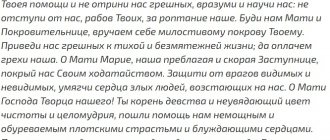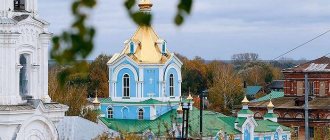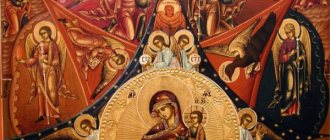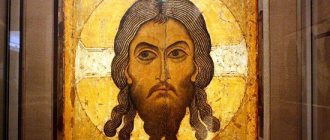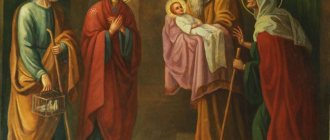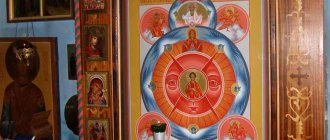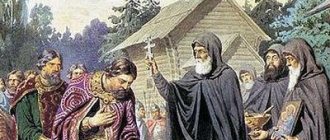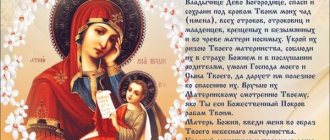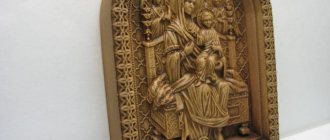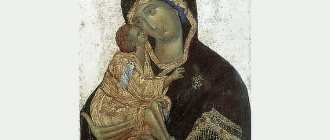"Save me, God!".
Thank you for visiting our website, before you start studying the information, please subscribe to our Orthodox community on Instagram, Lord, Save and Preserve † - https://www.instagram.com/spasi.gospodi/. The community has more than 60,000 subscribers. There are many of us like-minded people and we are growing quickly, we post prayers, sayings of saints, prayer requests, and timely post useful information about holidays and Orthodox events... Subscribe. Guardian Angel to you!
On this shrine, the Most Holy Theotokos is depicted at her happiest moment, even before the birth of her child, Jesus, but after the Annunciation. Against the background of the divine image, the Protector stands out with her enthusiastic facial features and bright image. The Virgin Mary is depicted with her arms crossed in a prayer gesture, her head slightly bowed and her eyes slightly lowered, which in turn is the personification of kindness, chastity and restraint. The Mother of God is sealed precisely when the angel Gabriel talks about what she is about to give birth to the Son of God.
Initially, the icon of the Mother of God of Tenderness was made on canvas, which was attached to a cypress board. Nicholas II donated a precious robe for the Tenderness icon. Who was able to see not only the purity of hearts, but also the soul of every person, and therefore he could ask for healing for Orthodox people.
The oil from the lamp burning near the shrine had healing properties, thanks to which, by anointing the sick, Saint Seraphim could heal from various ailments. The Reverend himself died right in front of the miraculous image while kneeling.
Then, in 1991, the face was transferred to Patriarch Alexei II in Moscow to be placed in the patriarchal church, but for veneration the shrine is annually transferred to the Epiphany Cathedral. Gradually, many copies began to be made from the divine image, and some of them had no less healing properties than the original.
In this article you will learn the meaning of the Tenderness icon, how the miraculous image helps, the prayer to the Mother of God, in which temples and churches the shrine can be located and much more.
- Prayer to the icon of the Mother of God Tenderness
The best article for you, go to: Icon of the Apostle and Evangelist Luke
History of origin
The image of Tenderness was formed, obviously, from the first centuries of Christianity, when, according to legend, the first images of the Blessed Virgin were painted by the Apostle and Evangelist Luke, who knew Her personally. After the Baptism of Rus', images of the Mother of God came to the Slavs. Already from the first centuries of Christianity in Rus', many of them, including icons of Tenderness, began to be revered as miraculous. There are many such icons today.
Vladimirskaya
Perhaps the most ancient icon of Tenderness known in Rus'. Apparently, the shrine is of Byzantine origin. It dates back to the 12th century, although there is a church tradition that attributes the authorship of this sacred image to the Apostle Luke. At first she stayed at a convent near Kyiv, later Prince Andrei Bogolyubsky transferred the image to Vladimir, which is why it got its name.
During the Soviet years, Vladimirskaya was among many other icons in the Tretyakov Gallery collection. And now her place of residence is the temple-museum at the gallery.
Novgorodskaya
The Novgorod icon became famous by a miracle on July 8, 1337. The watchman of the Trinity Church, where the icon was in the iconostasis, heard a noise and entered the temple to find out the reason. With horror, he saw that the icon of the Mother of God was inexplicably hanging in the air. Tears flowed from the eyes of the Most Pure One.
Church ministers immediately reported the miracle to the Novgorod archbishop, who came to the church with a procession of the cross and took the image in his arms. The new shrine was placed in a place of honor and an icon case was made. She immediately became famous for her miracles, including:
- deliverance of Novgorod from the pestilence of 1337;
- saving the church from fire in 1366 - the icon rose into the air from the burning church and again descended into the hands of the archbishop, after which the fire stopped.
In 1497, Grand Duke Ivan III took the Novgorod shrine to Moscow, but in 1508, the Mother of God, in a dream vision, commanded that Her Image be returned to Novgorod, which was done immediately. During the years of Soviet power, the museum took the shrine; later, when Novgorod was captured by the Germans, it was taken to Germany, but the image was returned in 1947.
Smolenskaya
The Smolensk Icon of Tenderness is one of the oldest. She appeared in Smolensk in 1103. The peculiarity of the image is the folded hands of the Virgin Mary. She looks with love at the Baby lying on the folds of Her clothes.
Smolensk has been glorified since the beginning of the 17th century, when Smolensk was besieged by the Poles. The heroic defense of the city, organized by governor Mikhail Shein, lasted 20 months. All this time the troops prayed in front of this image. Since then, Smolenskaya began to be revered as the patroness of the city.
Tolgskaya
There are 3 versions of the Tolga icon. The most famous list miraculously appeared in 1314 to the Rostov Bishop Prokhor on an island on the Volga, at the confluence of the Tolga River. At night, while praying, the bishop saw a pillar of light and a bridge across the river that suddenly appeared. Walking along it, the saint found a sacred image.
On the same day, a chapel was built at the site of the apparition, and later a monastery was opened. Until 1917, a pious custom was preserved: steamships traveling along the Volga invariably made a stop at the pier of the Tolga monastery so that passengers and crew could venerate the shrine.
Lokotskaya
This is a shrine that was revealed quite recently, in 1998 in the village. Elbow of the Bryansk region. It belongs to a special edition of “Tenderness”, where the Mother of God is depicted without the Child, and, as in Smolenskaya, with her hands folded in prayer on her chest. The Seraphim-Diveyevo icon of the Mother of God, known as the cell image of Seraphim of Sarov, belongs to the same copy.
A woman named Natalia saw a photocopy of this particular icon in a store on an old calendar that the sellers were going to throw away. In order to prevent desecration of the image of the Mother of God, the woman bought a calendar and, cutting out the image from it, hung it on the wall.
And on November 2, 1998, a paper icon, not even consecrated, became myrrhized. At the same time, another image of the Blessed Virgin appeared on the reverse side.
Archbishop Melchizedek learned about the miracle and personally certified its truth. First, a chapel was built for the new shrine at the house where it was located. Since 2012, the custodians of the image handed it over to the diocese. Nowadays Lokotskaya, whose myrrh-streaming does not stop, constantly visits different cities of Russia. Processions of the cross travel thousands of kilometers with her.
Holiday in honor of the icon “Tenderness”: when and how is it celebrated?
Become a courier of the Yandex.Food service right now (up to 3,400 rubles per shift) leave a request →
In honor of the Diveyevo Icon of the Mother of God of Tenderness, deeply revered in churches throughout the Orthodox world, celebrations are held, which are held three times a year at different times.
December 22 is celebrated as the day of the Venerable Seraphim of the Maiden Mill Community. Also, the celebration falls annually on August 1 and 10 according to the new style. On these days, it is customary in church to light candles in front of the icon for the health of one’s family and friends, read an akathist and special prayers, and also understand that meekness and humility before the will of God, which the Virgin Mary showed, should settle in the hearts of every Orthodox Christian.
Meaning
The iconography of Tenderness knows several types of images of the Mother of God:
- the most common: with the Christ Child; The Mother carefully and lovingly hugs the Baby Jesus, He presses his cheek to Her Face;
- The Mother of God looks with love at the Baby lying on Her clothes, the Mother’s hands are folded crosswise on her chest;
- The Mother of God is presented without the Child with her hands folded crosswise in prayer; such an icon is also called “Akathist”, since the inscription on it contains the words of the Akathist to the Mother of God: “Rejoice, Unbrided Bride.” This is exactly the icon of Seraphim of Sarov from Diveevo.
Despite the apparent strictness of the requirements of the canon, the icon painter has the opportunity to express different aspects of the meaning of the image using facial expressions, eyes, and movement:
- on the Novgorod icon of Eleus from the 13th century. The Mother of God, clutching her Son to Her, has a mournful Face, as if anticipating the suffering and Crucifixion of the Savior;
- on the icon of Tenderness of Smolensk in the eyes of the Mother of God, love for the Son, joy;
- The Tolga icon is distinguished by the fact that the Baby does not sit, but stands on the Mother’s knees, pressing his cheek closely to Her Face, directed towards Her with love. The face of the Mother of God is full of both sadness and love.
In general, the theology of the image speaks of the mutual love of God and man. But this high theology is clothed in a simple, understandable, close to everyone form of love between Mother and Child.
Therefore, Tenderness is often considered a “female” icon, and individual images of Tenderness are glorified specifically for helping women and girls.
Shrine locations
The original, presented by Nicholas II, is located in the Cathedral of St. Seraphim of Sarov, in Golitsyno. This image was painted in the 19th century. For over 40 years it was in the home of the icon painter who created it. The image of the Mother of God was transferred to the monastery at the first news of the beginning of construction.
One of the most revered images of the Virgin Mary is kept in the Trinity Monastery . The significance of the “Tenderness” icon of the Mother of God is difficult to overestimate for the Russian people. The shrine, famous for its colossal number of miracles, was painted by the nuns of this monastery at the end of the 20th century. Every Sunday, church hymns are held in front of the shrine.
What do they ask for in front of the image of the Blessed Virgin Mary?
The emotionality and expressiveness of the Faces of the Mother of God and the Child encourage believers, in case of difficulties, problems, illnesses, to turn to the Mother of God precisely through this image of Her. Especially often, in front of the icons of Tenderness, people pray about everyday and family problems.
Well-being in family and home affairs
In front of the shrine they often pray to overcome the difficulties of family relationships, pacify warring parties, and forgive enemies. The icon especially helps those who would like to have a child, because it depicts the happiness of the Mother and Child. There are many testimonies of miraculous help for infertile couples.
Success at work
Do not be embarrassed to ask the Most Pure One for such earthly problems and needs as success at work. It helps in all everyday matters, if there is God’s will to solve a particular problem. You should not ask the Mother of God for a successful career if you have ambition, a desire to infringe or humiliate others. But it is known that it is good to pray in front of the icon for healing from such a spiritual illness as pride.
About solving children's problems
Since the image helps, if it is necessary to reconcile warring parties, to get rid of mental burdens, people often pray before it to overcome the problems of adolescence in adolescents.
About health
You can pray in front of the icon for any illness. Especially this:
- infertility;
- women's diseases;
- children's illnesses.
Through the image of Tenderness, the Mother of God will certainly provide spiritual support to the patient, give spiritual strength and vigor.
About starting a family
Various icons of Tenderness are known for helping to create a family. Mothers especially often pray for their daughters:
- about maintaining purity and chastity;
- about a successful marriage;
- about the well-being of adult daughters.
Young girls who want to find a good husband also resort to the image.
About the bestowal of compassion and cordial mercy
The icon, representing the love of Mother and Son, is known for helping to overcome rudeness and rigidity of character. Before her, you can pray for an unmerciful person, and even those who suffer from a lack of compassion for their neighbors and kindness should also resort to the Mother of God.
Prayer
There are several prayers for the Tenderness icon
First
Oh, Most Holy Lady Lady, Mother of God the Virgin! Accept our unworthy prayers, save us from the slander of evil people and from vain death, grant us repentance before the end, be merciful to our prayers and give joy in sorrow a place. And deliver us, O Lady and Lady Theotokos, from all misfortune, misfortune, sorrow, illness and all evil, and grant us, Your sinful servants, to be at your right hand at the second coming of the Son. him, Christ our God, and our heirs will be blessed with the Kingdom of Heaven and eternal life with all the saints for ever and ever. Amen.
Second
Receive, O all-merciful, Most Pure Lady, Lady Theotokos, these honorable gifts, most useful to You, from us, Your unworthy servants: chosen from all generations, all creatures of heaven and earth the highest appearing, for for Your sake the Lord of Hosts be with us, and with You I know the Son of God and have become like His holy Body and His most pure Blood; Moreover, blessed art thou in the lineages of generations, O blessed one, the brightest of the Cherubim and the most honest of the Seraphim. And now, all-singing Most Holy Theotokos, do not cease to pray for us, your unworthy servants, so that we may be delivered from all evil advice and every situation and may remain unharmed from all poison. tago of the devil; but even to the end, through Your prayers, keep us uncondemned, for by Your intercession and help we are saved, we send glory, praise, thanksgiving and worship for everything in the Trinity to the One God and to the Creator of all, now forever and ever. Amen
